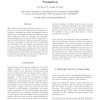Free Online Productivity Tools
i2Speak
i2Symbol
i2OCR
iTex2Img
iWeb2Print
iWeb2Shot
i2Type
iPdf2Split
iPdf2Merge
i2Bopomofo
i2Arabic
i2Style
i2Image
i2PDF
iLatex2Rtf
Sci2ools
ICRA
2002
IEEE
2002
IEEE
A Visual Landmark Framework for Indoor Mobile Robot Navigation
This article presents vision functions needed on a mobile robot to deal with landmark-based navigation in buildings. Landmarks are planar, quadrangular surfaces, which must be distinguished from the background, typically a poster on a wall or a door-plate. In a first step, these landmarks are detected and their positions with respect to a global reference frame are learned; this learning step is supervised so that only the best landmarks are memorized, with an invariant representation based on a set of interest points. Then, when the robot looks for visible landmarks, the recognition procedure takes advantage of the partial Hausdorff distance to compare the landmark model and the detected quadrangles. The paper presents the landmark detection and recognition procedures, and discusses their performances.
| Added | 15 Jul 2010 |
| Updated | 15 Jul 2010 |
| Type | Conference |
| Year | 2002 |
| Where | ICRA |
| Authors | Jean-Bernard Hayet, Frédéric Lerasle, Michel Devy |
Comments (0)

